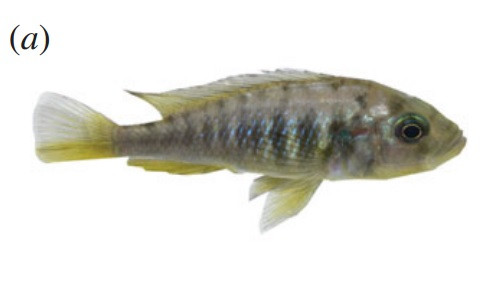Hopeful monster: Hybrid female fish 'develops testis' to give birth to offspring

A hybrid female fish isolated in a laboratory developed testis and gave birth to fertile female and male offspring. Further genetic analysis showed the cichlid – dubbed a hopeful monster – was both mother and father to the offspring, which were born over the course of a year at Hull University.
Self-fertilisation, or 'selfing', is often seen in insects and flowers. But it is very rare in vertebrates, where both male and females are normally required to produce offspring.
Scientists had been studying two species of cichlids – Crenicara punctulata and Cichlasoma portalegrense. In both of these species, sex change had been suggested. One individual cichlid was produced as a hybrid cross of the two species in a study of polymorphism and sex determination.
During the study they arrived at the aquarium to find this fish had produced four offspring. Over the next year, she produced 42 more. The findings are published in the Royal Society Open Science.
"In total, this intersex produced 14 broods, raising 46 living F2-juveniles over a period of 25 months while in isolation in a 20 × 20 × 20 aquarium. Two sons and 15 daughters survived to adulthood and were fertile," they wrote.
Hopeful monsters
The team kept 18 sibling sisters of the cichlid and its 12 daughters in isolation for 12 months to see if they would also display selfing, but none reproduced. When the male and female offspring were crossed, they produced offspring of both sexes.
Researchers believe the parents of the intersex cichlid probably possessed different sex- determining genes, but added the selfing witnessed was probably an "oddity" rather than a rule on account of its sisters not reproducing in this way.
"Nevertheless, rare hybridisation-fuelled 'innovation' could have adaptive potential by generating 'hopeful monsters' with novel traits for selection to act upon," the study said.
"To conclude, one [hybrid] individual developed into a functional selfing hermaphrodite after crossing two closely related sexually reproducing species of cichlids. Hermaphroditic selfing is likely to be under-reported in vertebrates because of the unusual set of conditions that is required for it to be observed... we suggest that although such 'hopeful monsters' may be evolutionarily transient and rare in nature, certain environmental conditions may make them biologically significant."
© Copyright IBTimes 2025. All rights reserved.






















